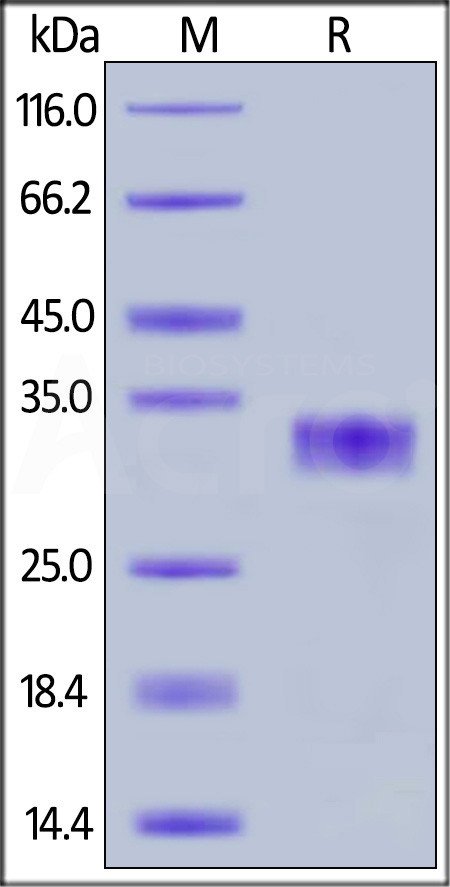分子别名(Synonym)
CXADR,CAR,CAR4/6,HCAR
表达区间及表达系统(Source)
Human CXADR, His Tag (CXR-H5222) is expressed from human 293 cells (HEK293). It contains AA Leu 20 - Gly 237 (Accession # NP_001329.1).
Predicted N-terminus: Leu 20
Request for sequence
蛋白结构(Molecular Characterization)

This protein carries a polyhistidine tag at the C-terminus.
The protein has a calculated MW of 24.9 kDa. The protein migrates as 32-35 kDa under reducing (R) condition (SDS-PAGE) due to glycosylation.
内毒素(Endotoxin)
Less than 1.0 EU per μg by the LAL method.
纯度(Purity)
>95% as determined by SDS-PAGE.
制剂(Formulation)
Lyophilized from 0.22 μm filtered solution in PBS, pH7.4. Normally trehalose is added as protectant before lyophilization.
Contact us for customized product form or formulation.
重构方法(Reconstitution)
Please see Certificate of Analysis for specific instructions.
For best performance, we strongly recommend you to follow the reconstitution protocol provided in the CoA.
存储(Storage)
For long term storage, the product should be stored at lyophilized state at -20°C or lower.
Please avoid repeated freeze-thaw cycles.
This product is stable after storage at:
- -20°C to -70°C for 12 months in lyophilized state;
- -70°C for 3 months under sterile conditions after reconstitution.
电泳(SDS-PAGE)

Human CXADR, His Tag on SDS-PAGE under reducing (R) condition. The gel was stained with Coomassie Blue. The purity of the protein is greater than 95%.
背景(Background)
Coxsackie virus and adenovirus receptor (CXADR) is also known as CAR, is a type I transmembrane glycoprotein for group B coxsackie viruses and subgroup C adenoviruses, and belongs to the CTX family of the Ig superfamily. CAR is strongly expressed in the developing central nervous system. It functions as a homophilic and also as a heterophilic cell adhesion molecule through its interactions with extracellular matrix glycoproteins such as: fibronectin, agrin, laminin-1 and tenascin-R. Human CXADR protein contains a signal sequence, a extracellular domain (ECD) with a V type (D1) and a C2 type (D2) Iglike domain, a transmembrane segment and a intracellular domain. D1 is thought to be responsible for homodimer formation in trans within tight junctions, and is necessary and sufficient for adenovirus binding. Variants of CXADR are attached to the cell membrane by a GPI- anchor.























































 膜杰作
膜杰作 Star Staining
Star Staining











